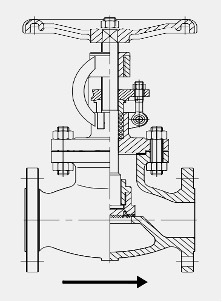
Globe Valve
图文详情
GLOBE VALVE
MANUAL
1、 Structural characteristics
This product is a straight through flange globe valve (see schematic diagram), and the working medium can only pass through from the direction indicated by the product arrow, so there are directional requirements during installation.

2、 Usage and performance specifications
1. Purpose: This product is a cast steel globe valve designed and produced by our company in accordance with the requirements of BS1873. Suitable as an opening and closing device for controlling the flow of media in pipelines such as gases, liquids, and oil products.
2. Performance specifications
|
Nominal pressure |
150Lb/300LB |
||
|
Nominal size |
NPS2-1/2-NPS8 |
||
|
Test pressure |
Shell Test |
3.0/7.5 |
MPa |
|
Back Seal test |
2.2/5.5 |
||
|
Sealing test |
2.2/5.5 |
||
|
Air tightness test |
0.6 |
||
- Main standards adopted
- The design and manufacturing technology shall comply with the provisions of BS 1873 for steel globe valves and globe check valves for petroleum, petrochemical and related industries (flange end and butt welding end).
- Inspection and testing shall comply with the provisions of API 598 for valve inspection and testing.
- The structural length of the valve shall comply with the face-to-face and end-to-end dimensions of ASME B16.10 valves.
4. The flange connection size of the valve shall comply with the provisions of ASME B16.5 steel pipe flanges and flange fittings.
4、 Main component materials
|
Part Name |
Valve body/valve cover |
Valve flap |
valve stem |
Sealing surface |
filler |
Shim |
bolt |
nut |
|
Materials |
A216 WCB+Sitali 6 |
A105+PTFE |
2Cr13 |
Sitai /PTFE |
graphite |
304+graphite |
A193 B7 |
A194 2H |
|
Part Name |
Valve body/valve cover |
Valve flap |
valve stem |
Sealing surface |
filler |
Shim |
bolt |
nut |
|
Materials |
A216 WCB+13Cr |
A105+13Cr |
2Cr13 |
13Cr |
graphite |
304+graphite |
A193 B7 |
A194 2H |
|
Part Name |
Valve body/valve cover |
Valve flap |
valve stem |
Sealing surface |
filler |
Shim |
bolt |
nut |
|
Materials |
bronze |
bronze |
SS316 |
body |
graphite |
316+graphite |
A193 B8M |
A194 8M |
5、 Installation
1. Install the product horizontally, but pay attention to the flow direction of the medium; Before installation, check if the product model and specifications are consistent with the requirements.
2. Check for impurities such as dust particles and rust blocks that may affect the sealing inside the valve chamber.
3. Check if the connecting bolts are tightened evenly.
4. Check whether the packing is tightly pressed, ensuring the sealing of the packing, but not hindering the lifting, maintenance, and upkeep of the valve stem.
6、 Possible faults and troubleshooting methods
|
Possible malfunctions |
Reasons for occurrence |
Clearing method |
|
Filler leakage |
1. The packing gland is not tightly pressed 2. Insufficient number of packing rings 3.Due to prolonged use |
1. Evenly tighten the nuts to press the packing tightly 2. Increase the number of packing rings 3.Replace with new packing |
|
Leakage between sealing surfaces |
1. There are dirt and debris adhering to the sealing surface 2. Damaged sealing surface |
1. Clean up the dirt and debris 2. The valve disc should be repaired and processed again |
|
Leakage at the connection between the valve body and valve cover |
1. Uneven tightening of connecting bolts 2. Damaged flange sealing surface 3. The gasket is broken or fails |
1.Tighten the bolts evenly 2. Rework 3. Replace with a new gasket |
|
Handwheel rotation not working properly |
1. The packing pressure is too tight 2. The packing pressure plate and packing sleeve device are skewed 3. Damaged or contaminated valve stem threads 4. The thread of the valve stem nut is severely worn or broken 5. Valve stem bending |
1. Loosen the nut on the packing gland appropriately 2. Correct the packing gland 3. Disassemble and repair nuts and remove dirt and debris 4. Replace the valve nut 5. Correct the valve stem |
- Maintenance and upkeep
1. Valves should be stored in a dry and ventilated room, and both ends of the passage must be blocked.
2. Valves stored for a long time should be regularly inspected, cleaned of dirt, and coated with rust proof oil.
- After installation, regular inspections should be carried out, and the main inspection items are as follows:
1) Wear condition of sealing surface.
2) The thread wear of the valve stem and valve stem nut.
3) Whether the filler is outdated and effective, and if it is damaged, it should be replaced in a timely manner.
4) After valve maintenance and assembly, a sealing performance test should be conducted. After each maintenance, the situation should be recorded in detail for future reference.
上一页
无
下一页
Related Products
Messages




